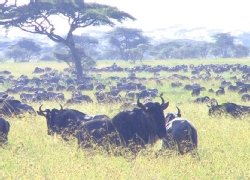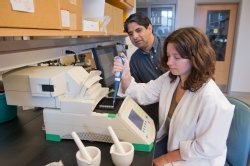Plants, and bacteria, and fungi! Oh My!
Study of Serengeti soil may provide model for increasing productivity of croplands in U.S.

Grass, root, and soil samples from the Serengeti plains of Tanzania are helping biologists in The College of Arts and Sciences learn how plant-eating animals, the plants they consume, and soil microbes thrive together. They believe these natural ecosystems may provide a model for making croplands more productive without using vast quantities of chemical fertilizers.
Plants need nitrogen and phosphorus to grow. While nitrogen comprises 80 percent of the Earth’s atmosphere, it is in a form plants cannot use. “It’s like living near an ocean, but dying of thirst,” says biology Professor Mark Ritchie. He is the principal investigator on a $535,373 National Science Foundation (NSF) grant to study the interaction between plants, bacteria, and fungi in their natural environment.
Some plants, such as beans, rely on certain bacteria to transform atmospheric nitrogen into a usable form. These nitrogen-fixing bacteria form tiny nodules on plant roots where they receive food in exchange for the nitrogen they “fix” from the atmosphere for the plant. It’s a mutually beneficial relationship. Likewise, soil is a natural source of phosphorus, yet plants have difficulty accessing the nutrient. That’s where fungi come in. Mycorrhizal fungi also live on plant roots. The fungi grow a network of tiny filaments that find the minutest sources of soil phosphorus and bring it back to the plant.
“In both cases, bacteria and fungi are donating goods to the plant in exchange for food,” Ritchie says. “While nitrogen-fixing bacteria have been studied extensively in agriculture, these interrelationships have not been widely studied in natural ecosystems.”
Plants need nitrogen and phosphorus to grow. While nitrogen comprises 80 percent of the Earth’s atmosphere, it is in a form plants cannot use. “It’s like living near an ocean, but dying of thirst,” says biology Professor Mark Ritchie. He is the principal investigator on a $535,373 National Science Foundation (NSF) grant to study the interaction between plants, bacteria, and fungi in their natural environment.
Some plants, such as beans, rely on certain bacteria to transform atmospheric nitrogen into a usable form. These nitrogen-fixing bacteria form tiny nodules on plant roots where they receive food in exchange for the nitrogen they “fix” from the atmosphere for the plant. It’s a mutually beneficial relationship. Likewise, soil is a natural source of phosphorus, yet plants have difficulty accessing the nutrient. That’s where fungi come in. Mycorrhizal fungi also live on plant roots. The fungi grow a network of tiny filaments that find the minutest sources of soil phosphorus and bring it back to the plant.
“In both cases, bacteria and fungi are donating goods to the plant in exchange for food,” Ritchie says. “While nitrogen-fixing bacteria have been studied extensively in agriculture, these interrelationships have not been widely studied in natural ecosystems.”

Ritchie and co-investigator, Ramesh Raina, associate professor and chair of the biology department, have developed a way to correlate the abundance of fungi and bacteria in soil and roots with nitrogen fixation. They study Serengeti herbs and Acacia trees, which are part of the same legume family as beans. Ritchie’s Tanzanian team collects, and places in plastic tubes, samples of plant roots and soil. They inject gas made of an isotope of nitrogen into the samples. The injected nitrogen isotope acts as a tag that can be measured to determine how much nitrogen was fixed by bacteria after about 20 minutes.
The samples then travel across the Atlantic to Syracuse University where Raina uses DNA analysis techniques to quantify the nitrogenfixing bacteria present. Collaborators at Northern Arizona University use similar techniques to quantify the fungi. Like humans, bacteria and fungi have a unique DNA signature. Raina uses a gene (which he cloned) that is present in all nitrogen-fixing bacteria to measure how many copies are in the samples. He can then determine how many bacterial cells are present.
“For decades, people have wanted to know how much nitrogen is being fixed in different ecosystems,” Ritchie says. “We have come up with a unique way to use molecular biology techniques—biology at a micro scale—to understand what is going on in the entire ecosystem—biology at its largest scale.”
The samples then travel across the Atlantic to Syracuse University where Raina uses DNA analysis techniques to quantify the nitrogenfixing bacteria present. Collaborators at Northern Arizona University use similar techniques to quantify the fungi. Like humans, bacteria and fungi have a unique DNA signature. Raina uses a gene (which he cloned) that is present in all nitrogen-fixing bacteria to measure how many copies are in the samples. He can then determine how many bacterial cells are present.
“For decades, people have wanted to know how much nitrogen is being fixed in different ecosystems,” Ritchie says. “We have come up with a unique way to use molecular biology techniques—biology at a micro scale—to understand what is going on in the entire ecosystem—biology at its largest scale.”
Media Contact
Judy Holmes
